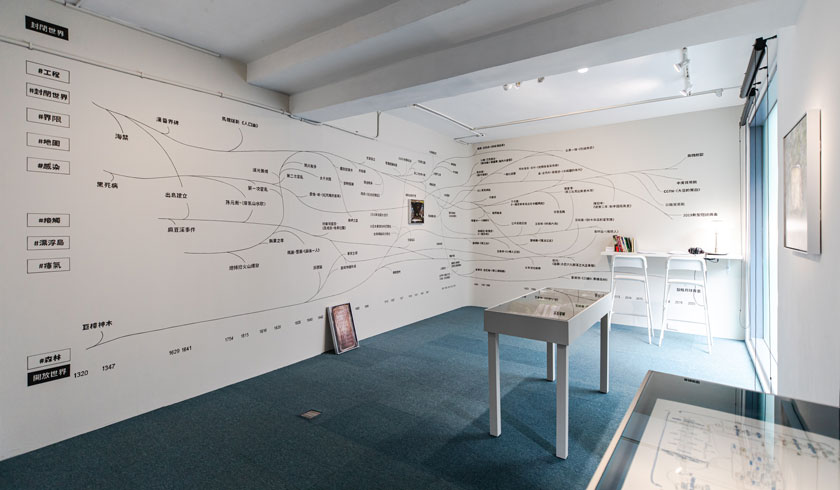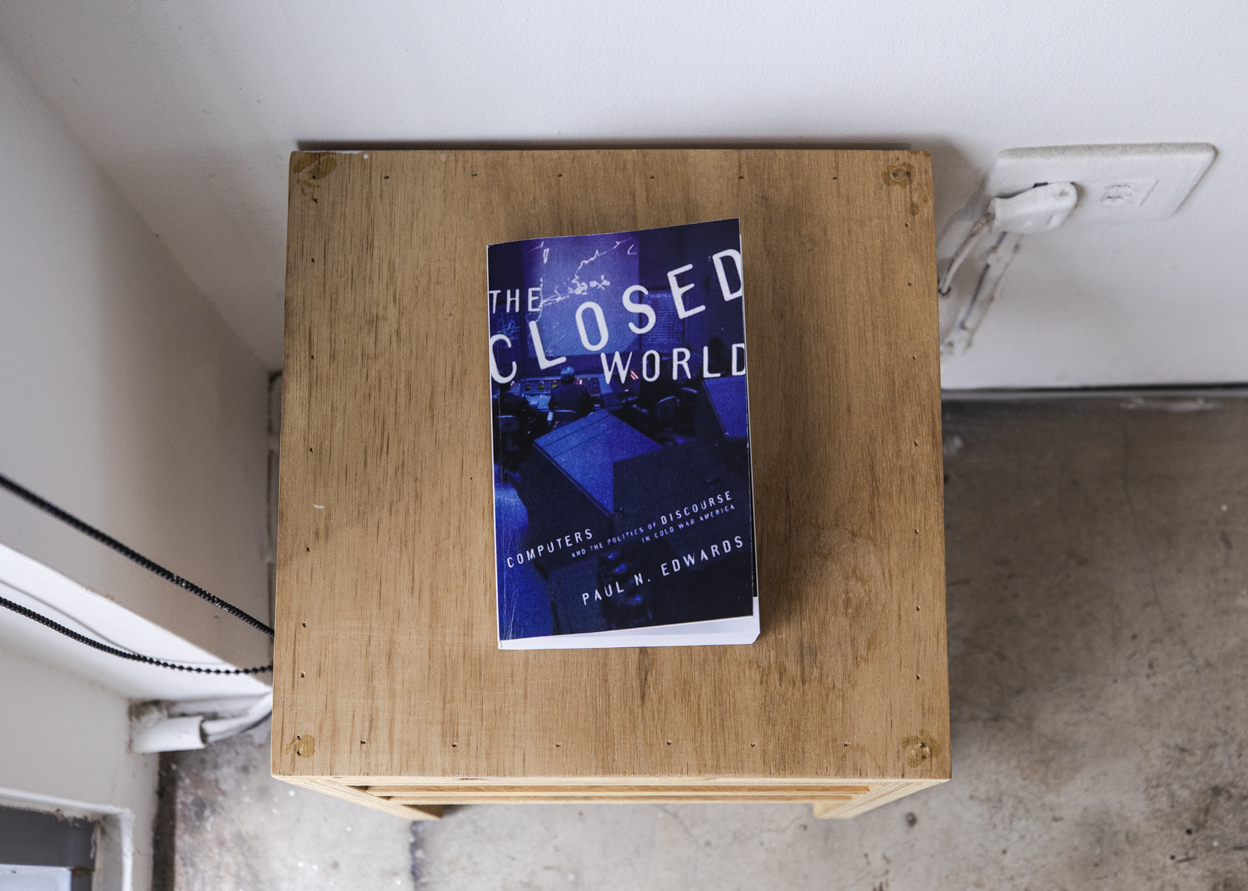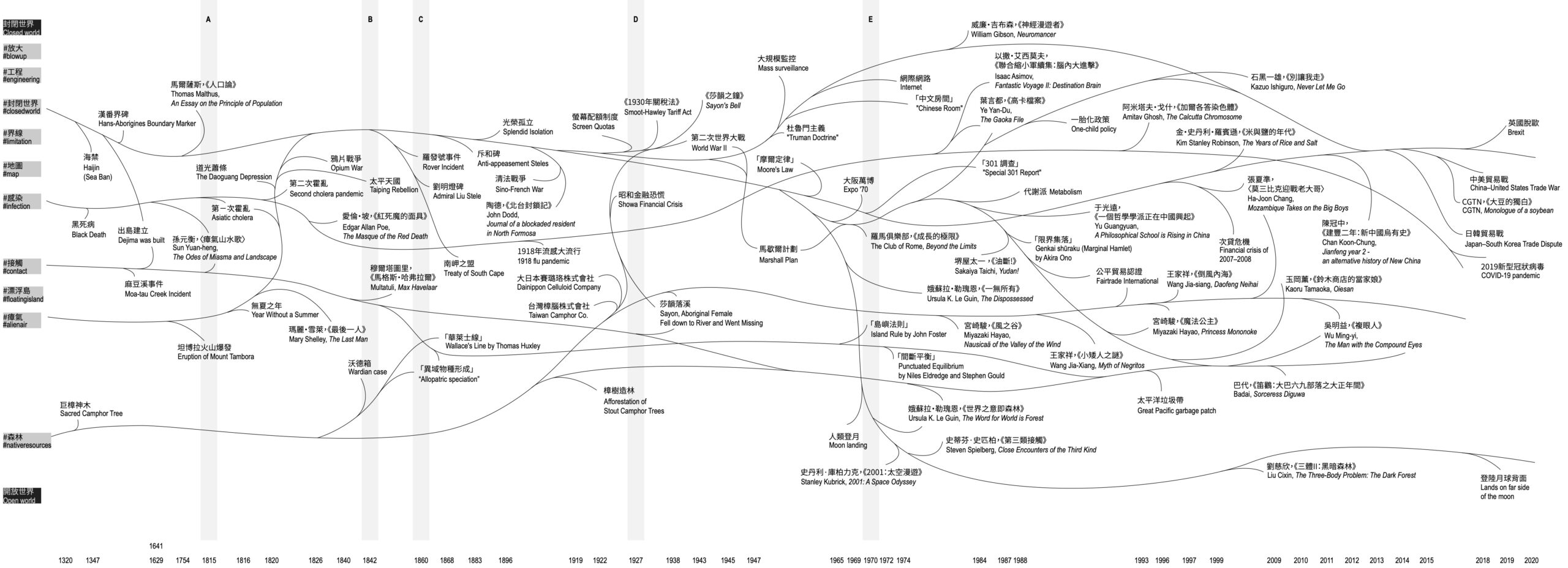Atlas of the Closed Worlds
Through the approach of scenario planning, Atlas of the Closed Worlds unfurls extensive research, stretching beyond historical facts along the long river of time, and including a cornucopia of changes in the surroundings and myriad imagined possibilities. Events from history and novels are amalgamated into a repository of information, generating different closed worlds through random numbers, evoking dystopian fantasies.
This project is inspired by the island rule in evolutionary biology. The hypothesis posits that an isolated environment, like an island, with a lack of resources or the disappearance of natural enemies, would prompt species to further evolve, developing new functions and assuming new appearances. The birth and extinction of an endemic species correlate with the isolation and connection between its habitat and the outside world. The project’s research first focuses on alien contact in science fiction, alluding to the encounters with the aborigines during the Age of Discovery, as well as the sea ban and closed country approach enforced in East Asia, which was a series of isolationist policies restricting maritime trading with other countries. Closed boundaries can be broken or rebuilt. As a protection strategy, closed boundaries — like quarantine measures during a pandemic — can be a double-edged sword. The rise of protectionism and populism has led to a wave of trade conflicts and tariff barriers that foregrounds the “our country first” mentality; boundaries are being drawn only to shape the next “closed country” scenario. Whether in reality or fiction, changing boundaries upon contact often only leaves room for a single perspective that tells a one-sided story, but the species that has helped cowrite the story upon the moment of contact, invariably becomes a silent existence in this narrative.
Atlas of the Closed Worlds simulates a scenario where an alien visitor who has arrived on Earth with a mission to gather information on closed worlds, while attempting to find a connection between the geographical characteristics of an island and particular worldviews. Upon reading this atlas, the alien realizes that Earth is in fact an island that operates amid the dark void. This perspective reflects the living environment of terrestrial species, as well as the structural evolution of human society. Ultimately, the alien matches critical points in time, places, and subjects with the narrow atlas of worlds provided by this planetary island, and identifies the extinction rate of the species, offering at last a guide of ecological entropy for the universe in the future.
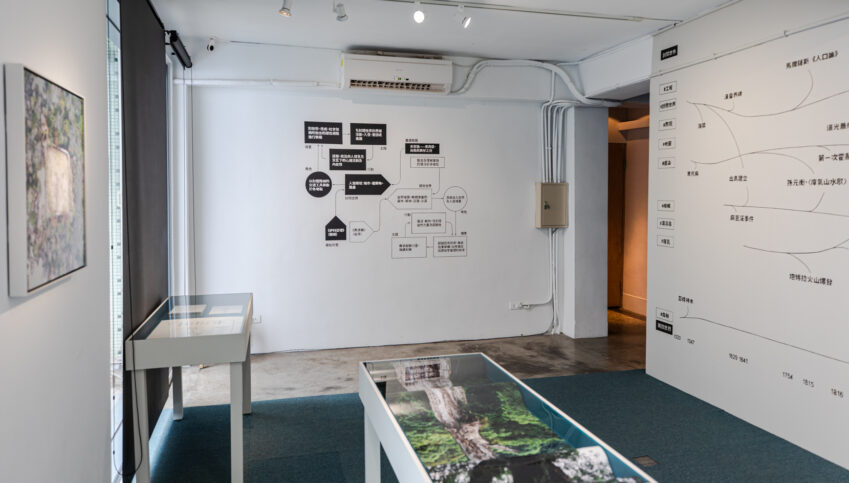
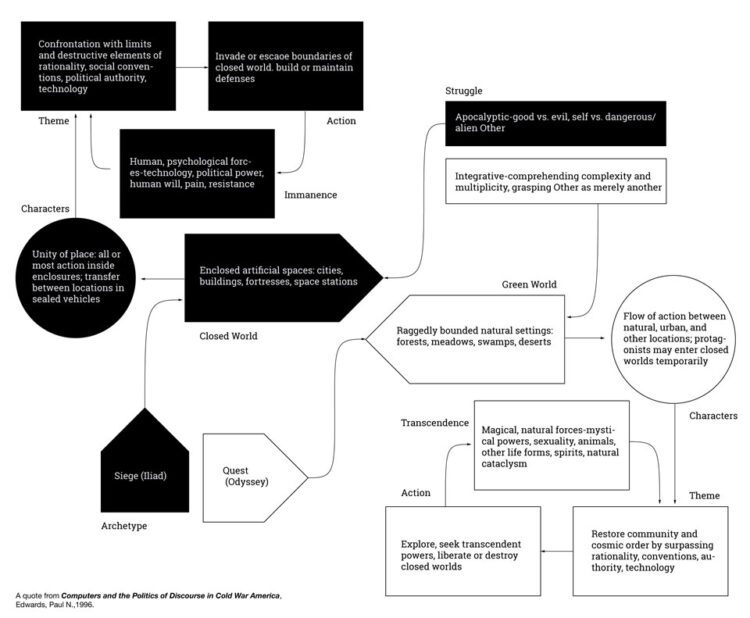
Closed Worlds and Open Worlds, Table, Paint, 2021
(Source: The Closed World: Computers and the Politics of Discourse in Cold War America by Paul N. Edwards)
The Chronicle of Closed/ Open Worlds, Ink, Dimensions Variable, 2020-2021
Image: Chi-Yu Wu. Text: Zian Chen, Chi-Yu Wu. Editor: Shiou-Hau Shiu
A
In 1815, the powerful volcanic eruption of Mount Tambora—a volcano located in present-day Indonesia—produced an enormous amount of ash that shrouded the Northern Hemisphere, which caused a period of significant climate change in the following year known as the Year Without a Summer. Records showed widespread harvest failures and famines across Europe and Asia. At the time, Mary Shelley and a group of Gothic writers trapped indoors in Geneva by persistent heavy rain started developing speculative writings about the apocalypse and their science fiction imagination. In a science fiction universe, certain narrative presuppositions of the universe allowed readers to tolerate sudden inexplicable appearance or disappearance of the unknown, which well mirrored the formative phase of science fiction. Perhaps apocalyptic science fiction indeed illustrated people’s state of mind two hundred years ago. Right before the volcanic catastrophe, Europe that had been weary of a prolonged period of upheavals eventually got away from the Napoleonic Wars at the expense of a burnt-down Moscow city, only to witness Asia plunged into the abyss of cholera pandemics at around the same time during the following years of lowered global temperatures.
B
London in the 19th century suffered from severe air pollution consequent to the spread of the Industrial Revolution. The air was so noxious that even garden plants could hardly survive. Some Londoners began using fully-glazed cases—Wardian cases—to protect plants from external pollutants. They then accidentally discovered that these cases not only worked for the said purpose but also found great use in transporting plants by watercraft across the oceans. With the new Wardian cases, tea plant seeds and tender young plants previously unable to endure long, large-scale sea journeys across different regions could be set on deck to benefit from the moisture circulated within the mobile greenhouse that kept them watered and alive. People who traveled from Europe, a temperate zone, to tropical areas and who had difficulties adapting to a new environment with different temperatures and humidity levels were inclined to associate the variations in ecosystems with that in cultures. Symptoms showing that temperate European minds were incompatible with tropical regions further enhanced their perception of microorganisms and alien entities found in the tropical air as etiological agents that could subvert the rational world.
C
In 1860, Dutch colonial officer Multatuli published Max Havelaar, a novel detailing systemic poverty in Dutch East Indies induced by the colonial government’s implementation of the cultivation system and a tax collection system in which the collecting agents were paid by commission. The reform brought about because of the novel eventually ended the local cultivation system. It further impacted the Indonesian National Awakening in the 1940s and even became a symbol to call for fair trade later in the 1980s. In 1857, the British empire that also faced challenges against the legitimacy of its colonial rule over India, on the other hand, developed nuanced modes of governance according to regional specificities and resorted to the study of comparative law to negotiate conflicts between common law systems that could accommodate particular world views and civil law systems that stressed universalism. In fact, it was exactly through these legal issues such as the cultivation system, taxation, and property rights that the settlers prompted the native’s identity into formation. Throughout the course of world history propelled by monsoons (in Southeast Asia), we see inevitable clashes that came with encounters between foreign systems. In light of the aforementioned multilateral dynamics, could we re-read Yao-Chang Chen’s Lady Butterfly of Formosa, a novel set in Taiwan in the 1860s and based upon the “Treaty of South Cape”?
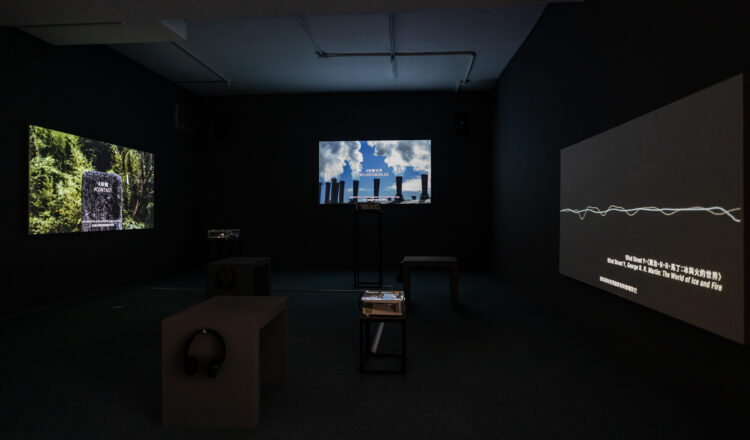
Atlas of the Closed Worlds-A Trip around the Island under the Global Lockdown, Randomized algorithm, 10mins, 2020-2021
Atlas of the Closed Worlds #Closed Worlds
Atlas of the Closed Worlds #Native Resources
In Conversation with Wu Ming-Yi, 41mins
